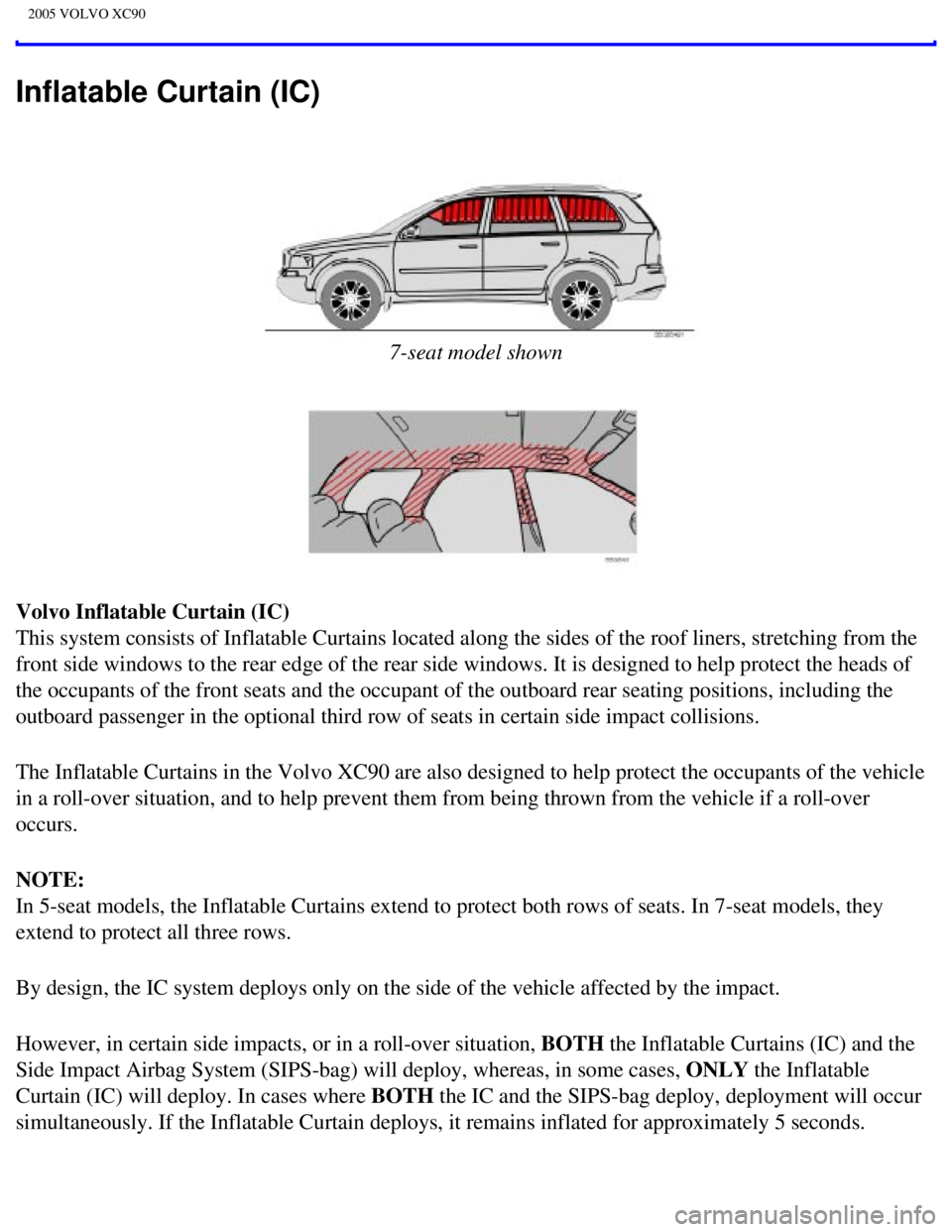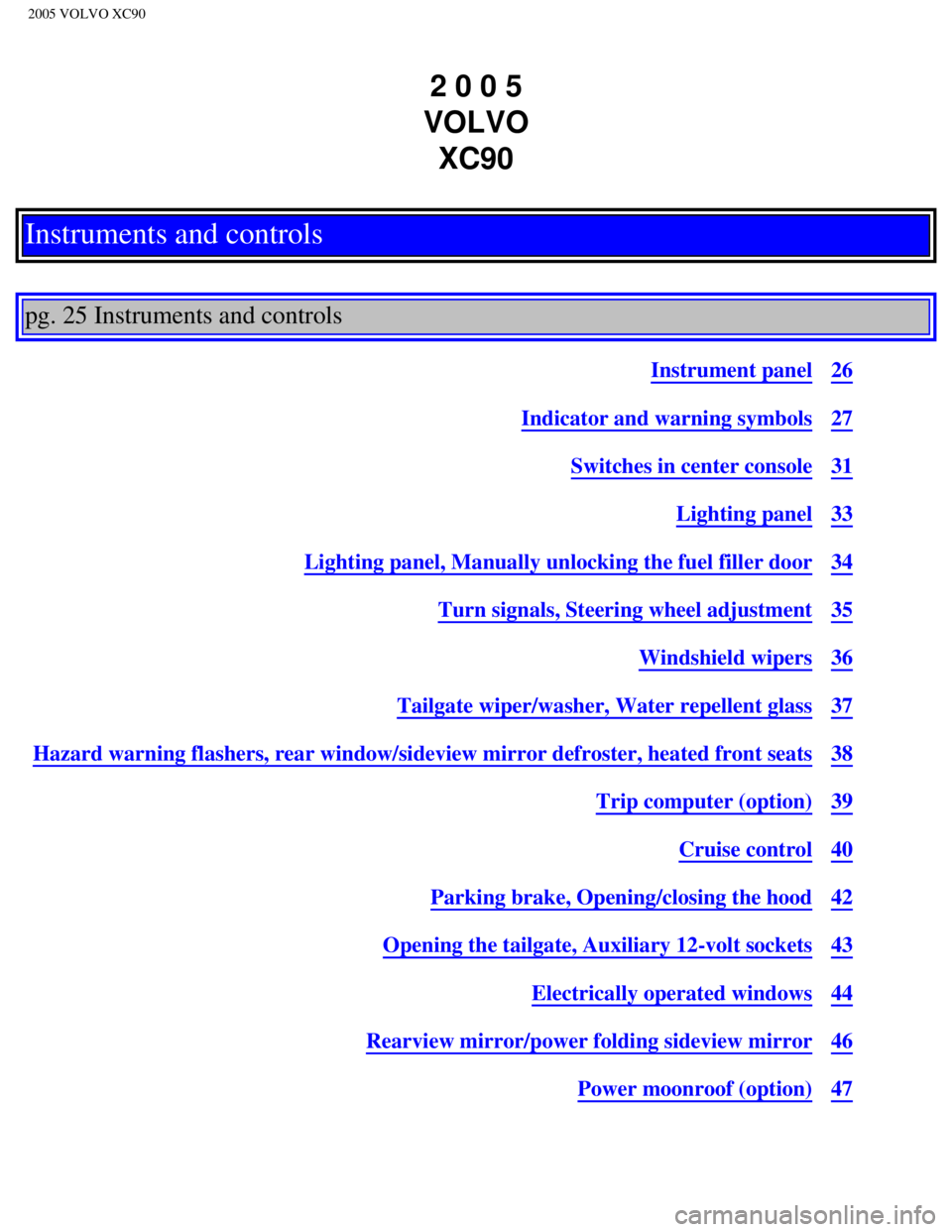2005 VOLVO XC90 window
[x] Cancel search: windowPage 6 of 263

2005 VOLVO XC90
1. Headlights/Parking lights 33
2. Instrument lighting 33
3. Panel vents 51
4. Text window 30
5. Temperature gauge 26
6. Odometer/Trip odometer/Cruise control indicator 26, 40
7. Speedometer iv
8. Turn signal indicator lights 26
9. Tachometer 26
10. Ambient temperature gauge, clock, gear indicator 26
11. Fuel gauge 26
12. Indicator and warning symbols 27
13. Panel vents 51
14. Glove compartment 69
15. Hazard warning flashers 38
16. Audio system 175
17. Switches in the center console 31
18. Climate system controls 52
19. Windshield wiper/washer lever 36
20. Audio control buttons in steering wheel 177
21. Instrument panel 26
22. Horn iv
23. Cruise control buttons in steering wheel 40
24. Turn signals, High/low beams 35
25. Front fog lights, Rear fog light 33
26. Parking brake pedal 42
27. Parking brake release handle 42
28. Button for unlocking fuel filler door 33
29. Hood open lever 42
30. Reading lights 65
31. Courtesy light 65
32. Moonroof control (option) 47
33. Seat belt reminder 29
34. Rearview mirror 46
35. Central locking button 79
36. Lockout switch for rear seat power windows 45
37. Power window controls 44
38. Sideview mirror controls 46
file:///K|/ownersdocs/2005/2005_XC90/05xc90_00.htm (6 of 7)12/30/2006 \
4:42:22 PM
Page 25 of 263

2005 VOLVO XC90
Inflatable Curtain (IC)
7-seat model shown
Volvo Inflatable Curtain (IC)
This system consists of Inflatable Curtains located along the sides of t\
he roof liners, stretching from the
front side windows to the rear edge of the rear side windows. It is desi\
gned to help protect the heads of
the occupants of the front seats and the occupant of the outboard rear s\
eating positions, including the
outboard passenger in the optional third row of seats in certain side im\
pact collisions.
The Inflatable Curtains in the Volvo XC90 are also designed to help prot\
ect the occupants of the vehicle
in a roll-over situation, and to help prevent them from being thrown fro\
m the vehicle if a roll-over
occurs.
NOTE:
In 5-seat models, the Inflatable Curtains extend to protect both rows of\
seats. In 7-seat models, they
extend to protect all three rows.
By design, the IC system deploys only on the side of the vehicle affecte\
d by the impact.
However, in certain side impacts, or in a roll-over situation, BOTH the Inflatable Curtains (IC) and the
Side Impact Airbag System (SIPS-bag) will deploy, whereas, in some cas\
es, ONLY the Inflatable
Curtain (IC) will deploy. In cases where BOTH the IC and the SIPS-bag deploy, deployment will occur
simultaneously. If the Inflatable Curtain deploys, it remains inflated f\
or approximately 5 seconds.
file:///K|/ownersdocs/2005/2005_XC90/05xc90_01b.htm (3 of 16)12/30/200\
6 4:42:25 PM
Page 26 of 263

2005 VOLVO XC90
WARNING!
The IC system is a supplement to the Side Impact Protection System. It i\
s not designed to deploy
during collisions from the front or rear of the vehicle. The Inflatable \
Curtains are designed to deploy
only during certain side-impact collisions, depending on the crash sever\
ity, angle, speed and impact.
The Inflatable Curtains are not designed to deploy in all side impact si\
tuations.
Never try to open or repair any components of the IC system. This should\
be done only by an
authorized Volvo service technician.
In order for the IC to provide its best protection, both front seat occu\
pants and all outboard rear seat
occupants should sit in an upright position with the seat belt properly \
fastened; adults using the seat
belt and children using the proper child restraint system. Only adults s\
hould sit in the front seats.
Children must never be allowed in the front passenger seat. See
page 22 for guidelines. Failure to
follow these instructions can result in injury to the vehicle occupants \
in an accident.
When the backrest(s) in the rear seat(s) are folded down, the vehicl\
e should not be loaded to a level
higher than 2 inches (5 cm) below the upper edge of the side windows. \
Objects placed higher than
this level could impede the function of the Inflatable Curtain.
pg. 15 Safety
Roll-over Protection System
Volvo's Roll-over Protection System has been developed to help prevent t\
he vehicle from rolling over in
the event of sudden evasive maneuvers, skids, etc and to offer enhanced \
protection if a roll-over occurs.
The system works in two ways:
l The stabilizing system Roll Stability Control (RSC) acts to minimize b\
ody roll.
l The system provides additional protection with a reinforced body, Inflat\
able Curtains for all outboard
seating positions, and seat belt pretensioners for all seating positions\
.
RSC uses a gyro-sensor that registers the vehicle's angle of inclination\
and the speed at which this angle
changes. Using this information, the control module calculates the risk \
of a roll-over. If there is an
imminent roll-over risk, the Dynamic Stability and Traction Control (DS\
TC) system is activated, engine
speed is reduced, and the brakes are applied to one or more of the wheel\
s until the vehicle has regained
stability.
If a roll-over occurs, RSC triggers the seat belt pretensioners and then\
deploys the Inflatable Curtains
(which remain inflated for approximately 5 seconds). These curtains ar\
e designed to follow the contours
of the side windows so that they position themselves between the occupan\
ts' heads and the sides of the
vehicle.
file:///K|/ownersdocs/2005/2005_XC90/05xc90_01b.htm (4 of 16)12/30/200\
6 4:42:25 PM
Page 39 of 263

2005 VOLVO XC90
2 0 0 5
VOLVO XC90
Instruments and controls
pg. 25 Instruments and controls
Instrument panel26
Indicator and warning symbols27
Switches in center console31
Lighting panel33
Lighting panel, Manually unlocking the fuel filler door34
Turn signals, Steering wheel adjustment35
Windshield wipers36
Tailgate wiper/washer, Water repellent glass37
Hazard warning flashers, rear window/sideview mirror defroster, heated f\
ront seats38
Trip computer (option)39
Cruise control40
Parking brake, Opening/closing the hood42
Opening the tailgate, Auxiliary 12-volt sockets43
Electrically operated windows44
Rearview mirror/power folding sideview mirror46
Power moonroof (option)47
file:///K|/ownersdocs/2005/2005_XC90/05xc90_02a.htm (1 of 17)12/30/200\
6 4:42:27 PM
Page 40 of 263

2005 VOLVO XC90
pg. 26 Instruments and controls
Instrument panel
1. Turn signal indicators - right - left
2. Text window
The text window displays information and warning messages.
3. Temperature gauge
The pointer should be approximately midway on the gauge when driving. Do not drive the vehicle if
the warning light is on. The text window will provide you with additional information. If the en\
gine
temperature remains high, check coolant level - see
page 139.
4. Trip odometer
The trip odometers are used for measuring shorter distances. The right-h\
and digit gives tenth of a mile/
kilometer. Press the button for more than 2 seconds to reset. Change bet\
ween trip odometers 1 and 2
using one short press on the button.
5. Odometer
6. Speedometer
7. Warning symbol
8. High beam indicator
9. Tachometer
The tachometer shows engine speed in thousands of revolutions per minute\
(rpm). Do not drive
file:///K|/ownersdocs/2005/2005_XC90/05xc90_02a.htm (2 of 17)12/30/200\
6 4:42:27 PM
Page 41 of 263

2005 VOLVO XC90
continuously with the needle in the red area of the dial, which indicate\
s maximum allowable engine rpm
range. Instead, shift to a higher gear or slow the vehicle down. The eng\
ine management system will
automatically prevent excessively high engines speeds. This will be noti\
ceable as a pronounced
unevenness in engine speed.
10. Gear and driving mode indicator
The currently selected driving mode is displayed here. If you use the op\
tional Geartronic function on the
automatic transmission, the currently selected gear will be displayed.
11. Ambient temperature gauge
This display indicates the air temperature outside your vehicle. A "snow\
flake" symbol in the text
window is displayed when the temperature is in the range of 23 - 36° \
F (-5 - +2° C). Please note that this
symbol does not indicate a fault with your vehicle. At low speeds or whe\
n the vehicle is not moving, the
temperature readings may be slightly higher than the actual ambient temp\
erature.
12. Clock/set button
Turn the button to set the clock.
13. Fuel gauge
The fuel tank holds approximately:
Models with 6-cylinder turbo engines - 19 US gallons (72 liters).
Models with 5-cylinder turbo engines - 18 US gallons (68 liters).
When a warning light in the gauge comes on, there are approximately 1.8 \
US gal. (8 liters) of fuel
remaining in the tank.
14. Indicator and warning symbols
pg. 27 Instruments and controls
Indicator and warning symbols
The indicator and warning symbols light up when you turn the ignition ke\
y to the driving position
(position II) before starting. This shows that the symbols are functio\
ning. When the engine starts, all
symbols go out. If the engine is not started within 5 seconds, all symbo\
ls except CHECK ENGINE and
go out. The symbol for the parking brake goes out when the parking brak\
e is released.
Warning symbol
in center of instrument panel
This symbol shines as a red or yellow light depending on the severity of\
the fault that has been detected.
Red symbol -Stop the vehicle as soon as possible in a suitable location and read th\
e message shown in
file:///K|/ownersdocs/2005/2005_XC90/05xc90_02a.htm (3 of 17)12/30/200\
6 4:42:27 PM
Page 42 of 263

2005 VOLVO XC90
the text window.
Yellow symbol -Follow the instructions shown in the text window.
Anti-lock brake system ABS
If the warning light comes on, there is a malfunction of the ABS system \
(the standard braking system
will still function). The vehicle should be driven to a Volvo retailer \
for inspection. See
page 98 for
additional information.
pg. 28 Instruments and controls
Indicator and warning symbols (contd)
BRAKE Brake failure warning light
If the light comes on while driving or braking, stop immediately, open t\
he hood and check the brake
fluid level in the reservoir. See
page 140 for reservoir position and page 144 for instructions.
Canadian models are equipped with this warning light.
If the BRAKE and ABS warning lights come on at the same time, this could\
indicate a fault in the
brake system.
l Stop the vehicle in a suitable place and switch off the engine.
l Restart the engine.
l If both warning lights go off, no further action is required.
l If both lights are still on after the engine has been restarted, switch \
off the engine again and check the
brake fluid level (see
page 140 for the location of the brake fluid reservoir).
file:///K|/ownersdocs/2005/2005_XC90/05xc90_02a.htm (4 of 17)12/30/200\
6 4:42:27 PM
Page 43 of 263

2005 VOLVO XC90
WARNING!
The If the fluid level is below the MIN mark in the reservoir or if a "B\
rake failure - Service urgent"
message is displayed in the text window: DO NOT DRIVE. Have the vehicle \
towed to an authorized
Volvo retailer and have the brake system inspected.
l If the brake fluid level is above the MIN mark, drive carefully to an au\
thorized Volvo retailer and
have the brake system inspected.
DSTC
The Dynamic Stability and Traction Control system (DSTC) is explained \
in greater detail on
pages 99
and 100.
pg. 29 Instruments and controls
Supplemental Restraint system (SRS)
If the light comes on (or stays on after the vehicle has started), the\
SRS diagnostic system has detected a
fault. Drive to an authorized Volvo retailer for an inspection of the sy\
stem. See the SRS section for more
information.
Generator warning light
If the light comes on while the engine is running, have the charging sys\
tem checked.
Seat belt reminder
This symbol lights up to indicate that the driver has not fastened his/h\
er seat belt.
Tire pressure monitoring light
file:///K|/ownersdocs/2005/2005_XC90/05xc90_02a.htm (5 of 17)12/30/200\
6 4:42:27 PM